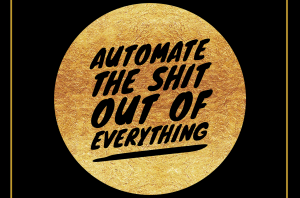
Credit cards. Debt. Mortgage. Mutual fund.
If you’re already bored and/or overwhelmed after reading that first line, keep reading – because that’s exactly how you can understand the opportunity NerdWallet saw in 2009, and how you can apply the same strategies to your business.
Starting as a simple Excel spreadsheetcomparing different credit cards, NerdWallet evolved into a full-scale personal finance authority website with over seven million monthly web visitors.
Chances are if you look up anything personal finance related such as “best credit cards” in Google, you will likely end up landing on something by NerdWallet.
In an exclusive ask-me-anything (AMA) with members of The Hustle Ambassadors Facebook group, NerdWallet’s VP of Content Maggie Leung and Director of Content Gerry Spratt provided insight on how NerdWallet was able to scale to a team of 90+ writers all over the country and consistently produce high quality content.
Maggie Leung is praised for her exceptional managerial qualities. She spent over 20 years in traditional news at publications such as The Washington Post, The Wall Street Journal, and, prior to starting at NerdWallet, was a senior editor at CNN.
Gerry Spratt formerly led a staff of five editors, 24 reporters, and two columnists at the San Francisco Chronicle and has been instrumental in NerdWallet’s growth and content quality control.
On the Importance of Content
NerdWallet’s CEO & Founder, Tim Chen, had his work cut out for him in 2009.
Not only is the financial services industry inherently not sticky for growth, there was also a growing public distrust of financial institutions thanks to the 2008 economic collapse. Additionally, NerdWallet’s competitors were literally made out of money and could fuel expensive growth campaigns.
Today, NerdWallet ranks for over 1.3 million keywords, consistently beating out heavy hitters like Bankrate (with a $900 million market cap), Credit Karma, Wealthfront, personal budgeting advisors such as Mint, and virtually every major bank, insurance company, and website with personal finance advice.
So, how did they pull it off? NerdWallet’s options were:
* Hope for organic referrals in an industry where there is extremely little word of mouth (how often do your friends brag about their credit cards?)
* Pitch financial topics to journalists who are getting bombarded with dozens of topics every day
* Launch an SEO campaign that would take years of work, especially for competitive high-value financial terms
* Use paid campaigns, which were prohibitively expensive
The only viable option was SEO, and this unleashed a massive firehose of traffic. To demonstrate, let’s take a look at one search term: “best credit cards”.
With a search volume of 90.5k and a cost-per-click (CPC) of $10.48, a simple valuation for the “best credit cards” search term is $948,448.
And that’s just one keyword.
By ranking #1 for search terms such as “best credit cards”, NerdWallet has been able to build a personal financial information empire. NerdWallet currently ranks for over 1.3 million keywords, with organic monthly traffic of over 5.7 million (valued at over $43m). How did NerdWallet do this?
Content.
You literally cannot rank for that many keywords without having that many words or combinations of words on your website, and even then your content must be extremely high quality to gather the attention, shares, and links to pick up in organic search rankings.
Here’s how the NerdWallet team successfully executed one of the most successful content strategies.
Maggie: Not every business requires a lot of content or quality content. It’s important to know your business, especially if you’re scaling. You don’t want to put your resources in the wrong place and blow your artillery off unnecessarily because you only have so much ammo…or bullets…or cannons…or whatever the shit is.
Maggie: There’s a difference between compromising your brand and making a conscious choice that you need to start somewhere and then get better and better. Not everybody is going to be able to start at A level content. I didn’t start with A level content at NerdWallet, there was no way I could possibly done that. We didn’t overnight hire 100 people, we had to scale this gradually. Keep looking for the feedback loop of where they’re adding value to your business. If they’re not, figure it out that you need to do something else. If they are adding value, increase slowly and make sure you’re making the right hires.
Gerry: In most advertiser model businesses, the content creators are an expense. It’s the cost of doing business whether its a freelance or in-house model. At NerdWallet we see content people as an investment.When we see new areas we need to grow into, the first step is often once we have a strategy, now we have to go hire writers and editors to execute on that strategy.
Gerry: Whenever there’s a sudden business need, it’s like, what are the heads that we need to address this need. If things were to get rough at us, we would look at our content team and think whether we need to deploy these resources within content or do we need to hire more people to drive the business faster. And content really is a business driver here and not an in-house expense.
On Hiring & Scaling a Team
NerdWallet was able to scale from 12 to 350+ people in only a few years. Whereas many business struggle to produce at scale, NerdWallet was able to take on the challenge while consistently producing high quality content to drive traffic.
NerdWallet’s first hire was a content writer. Now, they currently have a content team consisting of journalists, writers, and Pulitzer Prize winners spread across the country. A lot of this is credited to Maggie Leung’s phenomenal managerial abilities as well as setting the right processes in place for hiring and quality control.
On Hiring:
Maggie: If you hire the right people early on, they eventually make it easier and easier for you to do your job. For context, I scaled the team from 0 to 100. My job was much harder when I had to scale from 0 to 30, than from 30 to 70 and 100. My job is easier now because I have a really great bench.
Maggie: When we first started, we were hiring people who just finished school, but now we can attract people that are like Pulitzer Prize winners. Nobody wants to work for somebody that’s dumber or less talented than themselves. Internal referrals are great to find people who are a better fit, and it’s an easier sell to your new potential hires.
Gerry: If you read the first two paragraphs of a test, if you have to edit it over and over, you’re not really getting any leverage for yourself. You’re spending your own resources and your company resources. What is the cost of proceeding to the next step with this person versus the evidence that this person is only going to create more work for me or one of my managers. Does this person help us get better?
Maggie: I didn’t want to hire a shit ton of people and have to fire them all because we made some kind of stupid math error or stupid judgement. I was very thoughtful in how we hired people. If I thought something was experimental, I would lean towards hiring contractors rather than hiring full time people. I didn’t want people to quit a perfectly good job and come here and get fired. For me, that’s super important.
How do you find writers?
Gerry: Finding writers has been an evolution. First, we were looking for people that could adapt and adjust and grow with the team. We needed people that were comfortable with change and could scale with the company. As we grew, we recognized specific needs for each vertical. It became a balance of finding specialists versus finding people who are scrappy and have high aptitude in willing to learn. It’s been a luxury we’ve been able to mix and match in certain ways and build a team that covers that entire spectrum.
Gerry: If we decided we wanted to build a travel vertical, we could probably pluck a few of our scrappy writers and tell them to learn everything about that vertical and they would adjust great. On the other hand, some verticals such as investing require people with deep, deep domain expertise and you can’t just bring in one of the more flexible writers and expect them to write incredibly sophisticated investment content.
Maggie: In the early days of NerdWallet, even though some people are smart, hard-working, and conscientious, they weren’t people who had any training for actual editing and writing. Even though there were pieces here and there that were good, the overall content wasn’t great. If you start from a position where you have no credibility on your site, it’s important to find the right people for that early stage. We just have really high standards. We average a hiring rate of 1% for our writers, including people who are referrals. We don’t hire people that are just good writers; we hire people that will be good writers at NerdWallet. We hire for the long-term.
Maggie: I would go through their writing samples, and if they’re good, backchannel them. Check with their editors, because you don’t know what kind of raw material they’re turning into their editors. Then at the final stage, we test people to look at the raw material they turn in and see how it compares to our voice and tone even though we don’t give them that direction.
Maggie: We look at the gap between what we want, which is a 10, versus what they turn in. It’s not unusual for people to have a gap, and it’s rare for people to hit a perfect 10. Then, we create feedback about that gap and ask them, “What would you do to fix this?” You measure two things there: their actual ability and ability to take feedback. If they give you a stink about something wrong, then you’re revealing a problem. You can train people to write better and edit better, but you can’t train people to not be an asshole.
Maggie: You can do limited things with a tree stump, but imagine how hard it is to unroot a tree stump. That’s the same thing you’d have to do if you hired someone who can’t adapt and pivot with your startup.
Gerry: The writing/editing/journalism whatever you want to call it industry has become very insular. Everybody knows somebody who knows somebody who works somewhere now. If we weren’t transparent and responsible about how we were scaling up, we could not only undermine the reputation of NerdWallet, we could also undermine ourselves. The next place we end up we’ll be known as those people who had to fire 80 or 100 journalists.
What would you say were the biggest difficulties in scaling a team past a quantity of writers you can manage yourself?
Gerry: This starts with you. For some people, they’re not able to let go and trust people enough. That’s one thing you want to consider, whether you are the problem. If you’re a micromanager or aren’t trusting, you’re going to make it harder for anybody to succeed. Hire the right people and trust them.
Measuring Performance
When looking at the benefits of a good content strategy, businesses are often quick to pull the trigger on producing as much content as possible.
Unfortunately, this enthusiasm quickly fades when they realize that their content strategy isn’t headed in any particular direction. Meaningless KPIs such as words per month or articles per week are not only a bad way to measure the success of your content strategy, they could also set a subpar standard for your content production.
This is why it’s imperative to constantly benchmark your content to your specific business objectives. While there has to be a data-driven analytical component to your content, it’s important to also keep your content team motivated and creative.
Here’s how the NerdWallet team handles performance measurement.
Which KPIs do you use for writers?
Gerry: We don’t really think of KPIs for writers. The real measure of success for a writer here is what they’re able to deliver for their individual vertical and how well they’re aligned with the business. The core competencies of writing and researching are important, but what we look for his how a writer is integrating with the team, learning what the objectives for that team are, and performing well on those objectives. These objectives vary, so we don’t try to create uniform measures of success for our entire writing team.
Maggie: You don’t want to apply some kind of template, because each of our businesses are at a different level of maturity, and each of their needs will change over time. Universal KPIs wouldn’t be a good measure of accomplishment.
Maggie: We don’t use quotas because that’s not actually a good business result. The most important thing to us is to move the biggest rocks across our business. That can vary across different verticals. For us, it’s a measure of whether you are helping that business succeed. If you’re contracting out content, be very specific about what you’re looking for.
How do you hold people accountable for KPIs, and still preserve creativity?
Gerry: It really is making sure your team is aligned on specific vertical. Some things are non-negotiable. We know as a company there are some things we need to do to be successful, and we have content strategies that speak to what those needs are. We give writers/editors the option to use 10% time as an outlet if they feel boxed in by whatever they’re doing that quarter. We encourage people to use that 10% time to do something bigger and more aspirational. That often offsets that other type of work. We recognize that within content, we have a lot of room to grow beyond that service journalism informational decision helping content and making it more human interest. That doesn’t mean every vertical requires going out to interview people and find real people with real problems.
Gerry: There are places we’ve matured from a content standpoint where we’re able to supplement our foundational content with more human interest work. It works not only for verticals where we have that foundational content, but also newer verticals looking to build their audience that require that more human pieces. We’re different in that we’re not only trying to answer questions in a decision funnel, we’re really trying to find audience, which requires creativity from our writers and editors.
Maggie: Show people the destination you want to arrive at, and let them figure out how to get there. Open up the possibility that people can come up with different solutions to the question that you’re looking to answer.
What’s the reward structure for the team and how is the team structured?
Gerry: The team is structured against business needs. We know what our verticals are trying to succeed at, then we resources appropriately. We’ve potted up the majority of our editors and writers to be aligned with a specific piece of the business. The advantage is we can move faster and build domain expertise, and build strong editor/writer relationships within those smaller ratios. We’d have an editor or a team of editors with 3, 4, or 5 writers that are executing against a content strategy.
Gerry: Our content strategy is writing for a consumer with a very specific problem. As long as we can help that consumer solve a problem, that’s considered success for us. It’s more subjective than just metrics, but there are metrics involved. There are instances where a vertical can fail, but the writer’s job was a success. So it does require some context for what that business was trying to do, and then decide whether content as a service provided the piece for that strategy.
Maggie: Key thing is to understand what your goal is, then staff up for that. In some instances you might need a Swiss Army Knife. In the hiring process it’s important to find what the need is you’re trying to fill, and then hire the right kind of people for that specific purpose since not everybody will be a Swiss Army Knife.
Maggie: As far as the reward structure, let’s move away from a rewards structure and talk about motivation. Your motivations could be pure money, the type of responsibility, the visibility they get, the people they work with, or experiment and get exposure they don’t normally get. It’s super important to know your people and know what they want. If you can find that sweet spot in the middle of Venn Diagram of the shit they want to get done and the shit you want to get done where both of you are getting what you want, then you can drive all sorts of results that you otherwise wouldn’t be able to do.
Maggie: The key difference is that if you’re just paying people for the results, you never will get the same results if you had that person committed to the thing that they’re working on. We avoid hiring people that are essentially mercenaries. Mercenary situation can work for you in a freelancer situation, but that’s not the way we’re looking at our business. Content is our product. It’s our blood and we want to make sure that if we’re gonna that reliance on content, we treat the people we hire as huge investments, not as some sort of throwaway interchangeable cog.
On Company Culture
The freelancer and remote economy has given birth to an extremely talented pool of candidates for virtually every industry. The ability of being able to work with skilled individuals across the globe is often traded for a strong company culture.
Headquartered in San Francisco, one of the most expensive cities in the world, NerdWallet’s ability to scale up to 350+ people is largely due to its ability to maintain a good company culture with its employees located all over the country.
How do you build team culture with remote workers?
Gerry: This is a huge challenge for us. Our team is mostly remote. When I first joined the company 2+ years ago, I thought there was no way you could keep the culture strong with writers scattered all across the country. I think what we’ve managed to do very well, it starts with over-communication to help people understand the why and the strategy behind the decisions we’re making.
Gerry: At a more tactical level, we’re using all the software that’s at our fingertips to make sure their faces are on the screen, that we know what they look like. We know what they’re up to, what their interests outside of work are. Our team meetings are all done via zoom. We have very active slack channels for both work topics and extracurriculars where writers find they have shared interests. We have a very inclusive culture around things like team offsites and any team building activities. We can’t really invite the entire team to San Francisco to go bowling, but what can we do when the San Francisco people go bowling to make the remote people feel like they are a part of that activity.
Maggie: I knew I was going to hire a lot of people remotely. I knew what the experience was like on the other end, and I wanted to create something much more engaging. When you start with the goal and you figure out how to do that, it becomes pretty straightforward:
Maggie: It’s really about feeling connected, having access to the right kind of information, not being forgotten, being appreciated for the person you are, not just a cog in the wheel of just 100 writers. It doesn’t matter if you’re a writer, editor, or manager, the key thing is we want you to feel as much a part of NerdWallet as if you were with us in San Francisco at our headquarters where about 400 people work.
Gerry: We do a good job in the hiring process of finding the people that are comfortable telecommuting. Most of our telecommuters are the type that want to get themselves in front of a group as much as possible and want to be involved. We don’t necessarily really look for the type of telecommuter that just want to take assignments, be invisible, and crank out stories. It’s really a two way street. We do everything we can to include them, but it’s up to the individual to participate.
Maggie: Every spot on your team actually has the ability to deliver some sort of leverage to your team. If your team is giving ideas and offering feedback whether it’s on feedback or actual processes or other opportunities, that means they’re delivering at full value. Everyone that doesn’t do that is delivering suboptimally. So that’s what we look for: how are you going to show up? How are you going to be a resource to your team?
On Tools
Part of working at a high input and fast pace in the modern world requires the ability to leverage all the possible technology that helps you automate or simplify lengthy processes. The majority of the tools NerdWallet used to scale their team are affordable and within reach for virtually any company looking to connect their team, manage projects, and hold meetings.
Which tools do you use to manage your team of writers, and which do you recommend for a smaller operation?
Gerry: We use Slack, for the production process we use Asana, and then the actual production is done in WordPress. The most important takeaway is to make sure that your tools are scaleable. A lot of tools may seem scaleable as you start using them, as your team doubles or triples in size, you find out they’re much more cumbersome than you originally anticipated.
erry: We like Asana because it increases visibility between projects, and it’s much easier to manage what’s coming down the pipe, what redundancies we have to solve for, etc. On Slack, we have an overarching content work channel where we talk about the important day to day stuff. If Content play is related to content but more conversational, then we have content specific work channels.
Maggie: It’s important to have a “watercooler” sort of channel to help people bond and talk about more conversational things. It helps to feel people connected. The key thing is how do you measure whether people feel connected or not. Our team is highly cohesive. For instance, when somebody on our team asks for help, you get 20 responses from our team of 100 people.
On Content Creation
Creating content at scale requires not only building systematic processes that simplify research, content creation, and editing, but also finding a way to integrate your brand’s voice and creative angles.
A common situation for businesses pursuing a long-term content strategy is becoming overly dependent on a single writer, and then suffering a derailment in content creation and quality when trying to find another writer that perfectly matches the previous tone and voice.
This is a situation that NerdWallet has been able to handle exceptionally well.
How do you keep the quality of your content high when you’re no longer creating it yourself?
Maggie: Scaling requires you to let go up to some point. This is how I generally know to calibrate myself with trusting people. If I ask someone to do something and they do it at 80% of what I would considered 100%, I’m good. Because essentially that means I bought myself leverage. I don’t expect everyone to be a clone of me. You don’t want people who think like you or just act like you. Your goal is to move the quality of your content up incrementally as fast as you can. Our goal is to keep elevating both the content and the calibre of people we’re hiring.
Gerry: We’ve scaled intelligently in the sense that if we hire three writers, we will also probably hire an editor.The structure is just the beginning of it. The next part is hiring people with the expectation that they’re going to build domain expertise. It requires trust, but it doesn’t mean we turn our backs and go worry about something else. At the scale we’re at now, to have our hands on every piece of the product is not a reasonable expectation. We have to bring in the right people and trust that they’ll do their jobs well.
Maggie: The key thing is to give people the space they need to do the work they think is appropriate for that job. Do you have enough time to write a quality story, or do you just have to crank something out. Are you cranking things out that are B or C level quality when you could be doing A level?
Maggie: That doesn’t mean all [businesses] need A level content. Some [businesses] are good enough with C+ level content, but at NerdWallet, since trust is so important to our personal finance decisions, there’s no negotiating that. We know we have to hit a high calibre quality level. As far as other places, if you’re willing to settle for C and that’s good for your business, that’s great, that’s easier to find those kind of people. It’s really hard for us to find those kind of people that we need. There’s not really many of them in the universe of content production.
How do you manage a consistent voice and tone?
Gerry: Our team is filled with multi-generational writers from people fresh out of college to long-term veterans. It is hard to maintain consistency, but we think about consistency the same way we think about motivation. It’s not a one size fits all. Having a little bit of variety of tone has its advantages. We have writers all over the country, and we speak to a similar audience.
What is the content research process like?
Gerry: We take a somewhat traditional approach to that. We do more research than traditional reporting, but we really do put the onus on reporters. If they have a topic where they’re 50% confident about they’re writing about, we ask them to go out and do the research and get to 95 or 100% with the understanding that they’re going to work with an editor.
Gerry: We have encouraged our writers to get better at the reporting side of things like talking to sources and talking to real people. There’s a tendency for younger writers to be research driven, they’ve never really picked up a phone and called people and asked them to explain something to them for a better understanding. But thankfully we have people on our team that have been doing this their entire career and can help mentor.
Final Thoughts
While it may be unreasonable to assume every business will be able to scale to NerdWallet’s level, the principles in this discussion can be applied to greatly improve any business’s content process.
By placing a higher emphasis on high quality creation, businesses will be able to not only push the needle on their marketing efforts, but they will provide their audience with valuable and useful solutions to their problems. It won’t be easy, but it will be worth it.
By the hustle
Want to start your own content business? Click here to upgrade to slay club world





